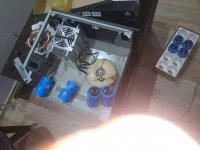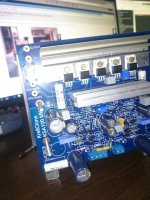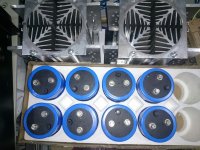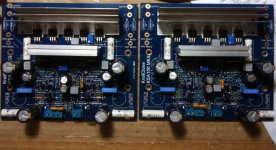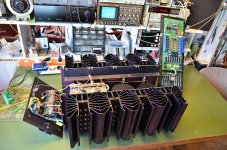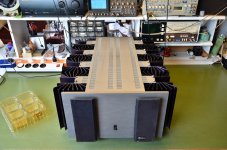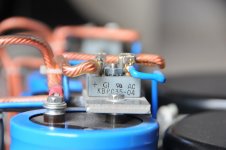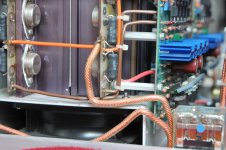Is a big class A really worth it? 1300w is like a hair dryer on all the time. I know that it can heat a room. Water cooling may make sense as you can pipe it to a radiator outside the room/house.
Actually that was my question on my very first post on this thread. does it make that big a difference? Can you make the class AB sound as good? I incline to want to make an amp with a few watts of class A and go into class AB on higher signal level. Most music stay within the first 5W of power ( that's loud already). It's the transient that we want the headroom. Maybe class AB with a few class watts is good enough. Lots of people go with single ended class A tube amp that is less than 5W total output. Apparently they are happy with it. I went and listened to a Cary single ended tube amp, it was very impressive even at reasonably high volume.
Last edited:
I think good class AB amp has just as low distortion as good class A. Class A makes sense for driving high sensitivity horns and tweeters, and headphones. Big woofers don't need class A.
Glad to see this thread is still running after nary a decade. Would have liked to see more of the boards I spent so much time designing being used (considering how many got built but like tadpoles how few ended up as finished projects), but at least some did make it. Hope those that did are still in daily use.
Regarding the comments about the JimAudio boards being the closest to the originals, I have to comment that the ones in the Group Buy were made to be drop-in replacements to the original boards for those with blown/ruined amps. The original design, form factor, parts etc. was copied from the original and then some improvements made to routing and optional extras added such as local decoupling and LED's.
Regarding the comments about the JimAudio boards being the closest to the originals, I have to comment that the ones in the Group Buy were made to be drop-in replacements to the original boards for those with blown/ruined amps. The original design, form factor, parts etc. was copied from the original and then some improvements made to routing and optional extras added such as local decoupling and LED's.
Thanx for all your efforts Pwatts.
Mine are still going strong from 2007 without issue.
Have 3 blue boards left and might do it again since I have the original pts that Krell used for maybe 2 more.
That is the issue that originals pts. are getting hard to find and probably why many give up even trying a build of this model again.
Regards
David
Mine are still going strong from 2007 without issue.
Have 3 blue boards left and might do it again since I have the original pts that Krell used for maybe 2 more.
That is the issue that originals pts. are getting hard to find and probably why many give up even trying a build of this model again.
Regards
David
Where are you?
I have three matched pairs of 5309 in the UK.
Hi AndrewT,
Do you still have the 5309's. I would be interested in purchasing them.
PM me.
Regards
Newark has them, a bit pricey though.
I'm not using the original fets as you are (mine are 2SK2013/2SJ313). I'm wondering if a jfet CS would allow for more flexibility?
ps. this is my first spice circuit, please correct me if my thinking or my device chosen is incorrect
I'm not using the original fets as you are (mine are 2SK2013/2SJ313). I'm wondering if a jfet CS would allow for more flexibility?
ps. this is my first spice circuit, please correct me if my thinking or my device chosen is incorrect
Attachments
Hi AndrewT,
Do you still have the 5309's. I would be interested in purchasing them.
PM me.
Regards
Why only the 1N5309? and not the 5310, its only .3mA higher... Builders are using different Mosfets, which are also having differences in VGS .. that current is divided between the two Mosfets so it only adds 0.15mA to each device, which is nearly nothing.
I think these should be pretty close to a drop in
http://www.mouser.com/ProductDetail/Semitec/E-352/?qs=sGAEpiMZZMtQ8nqTKtFS/G7SPLwmKeGy7MokZFFD704=
http://www.mouser.com/ProductDetail/Semitec/E-352/?qs=sGAEpiMZZMtQ8nqTKtFS/G7SPLwmKeGy7MokZFFD704=
As far as I know the only fixed bias Krell with such a huge heatdissipation was the Krell Reference KRS-200 that consumed 7 Amps per channel on 75 Volts rail and consumed 1050 Watts per hour (they were mono's) and had large protruding heatsinks that were dersigned to dissipate 130 Watts each and were much larger then a KSA-250.How do people deal with amp like KSA250 that constantly generates 1300W or heat? I have a Nakamichi PA-7 and I did at one point adjust it to 70mA per stage. So for 7 stages, it's about 0.5A. Supply is 150V total, that's only 75W of heat per side and 150W total. The room got really warm in the summer. Air conditioning does not even help because the thermostat is in another room. If I turn down the temperature, the other room will be too cold.
You are talking at least 8 times the heat with the KSA250. How do you deal with it? I had to back off the bias to factory spec of 40mA per stage of the Nakamichi to keep the room cooler. I read here people use water cool, isn't that over board?
Can the heatsink on the KSA250 able to dissipate 1300W in air only?
When I build my power amp, I think I would bias to have a few watts in class A and class AB at higher power. I can't take the heat in the room.
They could muster Class A power up to their 4 Ohms specification of 400 Watts.
(Credits: Jacco Vermeulen member from 2004 on, shared this information already on this forum)
According to Jacco a KSA-250 draws 600 watts from the wall that would be good for a 100 Watts Class A per channel max.
No way the KSA-250 did deliver all it's power as Class A. The heatsinks had to be even bigger as the KRS200 and that's only a mono!
http://www.diyaudio.com/forums/attachment.php?attachmentid=594788&stc=1&d=1485433148
http://www.diyaudio.com/forums/attachment.php?attachmentid=594788&stc=1&d=1485433148
Attachments
Yes, those sinks on the KSA-250 can dissipate all that power very easily. Those sinks are extremely efficient, and each sink is something like >800 sq inches of surface area. I used identical sinks on my Aleph 2's.
If you are building a standard KSA-100 as per the group build I suggest putting in a switch so you can have a summer-winter bias setting. (be sure to only change the switch if amplifier is powered off!)
Or... Consider water cooled heat sinks (which are not too hard to make). Letting the heat exchanger dissipate the heat some place else other than the listening room itself. This way you can stay nice n cool.
Even my KSA-50 warms up my basement room in the summer if it runs 24/7.
Mark
If you are building a standard KSA-100 as per the group build I suggest putting in a switch so you can have a summer-winter bias setting. (be sure to only change the switch if amplifier is powered off!)
Or... Consider water cooled heat sinks (which are not too hard to make). Letting the heat exchanger dissipate the heat some place else other than the listening room itself. This way you can stay nice n cool.
Even my KSA-50 warms up my basement room in the summer if it runs 24/7.
Mark
The KSA-250 was not fixed bias to 250w. If memory serves, D'Agostino tried it but the amp heated up more than he liked. He then developed a circuit that is fixed to about 100w , then varies the bias with the signal to keep it in class-A till 250w, without the penalty of huge idle draw. This then led to the development of the sustained bias operation of the KSA-300s (s for... you guessed it). This design ramped up the bias with the signal just like the 250, but did not ramp it down, rather sustained it for a time period, but not indefinitely. I owned both the KSA-250 and the KAV-250a.... and much prefer the sound of the KAV.
Interesting new information.The KSA-250 was not fixed bias to 250w. If memory serves, D'Agostino tried it but the amp heated up more than he liked. He then developed a circuit that is fixed to about 100w , then varies the bias with the signal to keep it in class-A till 250w, without the penalty of huge idle draw. This then led to the development of the sustained bias operation of the KSA-300s (s for... you guessed it). This design ramped up the bias with the signal just like the 250, but did not ramp it down, rather sustained it for a time period, but not indefinitely. I owned both the KSA-250 and the KAV-250a.... and much prefer the sound of the KAV.
I always wondered how the KSA-200 and its successor the KSA-250 were biased.
If you look at the KRS-200 mono amp in my last post you can see how much heatsink you need to get 400 Watts of Class A @ 4 Ohms. I always saw the KRS-100 & KRS-200 amps as huge Levinson ML-2's and a design to keep the fixed bias Class A of the KMA-100 & 200 without the forced cooling with the Papst fans.
Just bought a Krell KSA-100 Mk2 to fight the cold winter here.
It's minus 5 Centigrade now but with the winds blowing from Russia it's feeling like minus 10. My house is at a isolated place in the country, have no neighbours (that's great with hifi) and I'm strugling to get it 17 degrees indoors.
I already decided to replace the feedbackcaps on the mainboard the Roedersteins 1000uF/16V and I'm looking for replacements for the 30 years old Sprague 40mF/75V powerlytics.
Cheap: Nippon Chemicon U36D Series 100mF/80V for around 40 USD the piece.
Expensive: Kemet PEH200 Series 100mF/63V for 90 USD the piece.
Unobtainable: Kemet PEH169 Series
Krummer caps any good/experience? Schraubanschluss-Kondensatoren - DeutschDeutsch
How important are these powercaps anyway?
Does the bridgerectifier (KBP C3504, 35 amps) handle the greater capacitance of 40 vs 100mF?
Can I use a 63V (75V peak) on the 52V rails instead of the original 75V?
A technician, which I'm not, said that these feedbackcaps are important and if you replace them with fresh caps (he used to work for Krell and advised me the Panasonic FM Series) with higher caprating the bass wil be improved on.
Can anybody explain to me how this works?
Does anybody know what those heavely soldered 10Ohm powerresistors are doing on the bottom of the amp?
Thanks in advance!
http://www.diyaudio.com/forums/attachment.php?attachmentid=598392&stc=1&d=1486739947
http://www.diyaudio.com/forums/attachment.php?attachmentid=598393&stc=1&d=1486739947
http://www.diyaudio.com/forums/attachment.php?attachmentid=598394&stc=1&d=1486739947
http://www.diyaudio.com/forums/attachment.php?attachmentid=598395&stc=1&d=1486739947
http://www.diyaudio.com/forums/attachment.php?attachmentid=598396&stc=1&d=1486739947
It's minus 5 Centigrade now but with the winds blowing from Russia it's feeling like minus 10. My house is at a isolated place in the country, have no neighbours (that's great with hifi) and I'm strugling to get it 17 degrees indoors.
I already decided to replace the feedbackcaps on the mainboard the Roedersteins 1000uF/16V and I'm looking for replacements for the 30 years old Sprague 40mF/75V powerlytics.
Cheap: Nippon Chemicon U36D Series 100mF/80V for around 40 USD the piece.
Expensive: Kemet PEH200 Series 100mF/63V for 90 USD the piece.
Unobtainable: Kemet PEH169 Series
Krummer caps any good/experience? Schraubanschluss-Kondensatoren - DeutschDeutsch
How important are these powercaps anyway?
Does the bridgerectifier (KBP C3504, 35 amps) handle the greater capacitance of 40 vs 100mF?
Can I use a 63V (75V peak) on the 52V rails instead of the original 75V?
A technician, which I'm not, said that these feedbackcaps are important and if you replace them with fresh caps (he used to work for Krell and advised me the Panasonic FM Series) with higher caprating the bass wil be improved on.
Can anybody explain to me how this works?
Does anybody know what those heavely soldered 10Ohm powerresistors are doing on the bottom of the amp?
Thanks in advance!
http://www.diyaudio.com/forums/attachment.php?attachmentid=598392&stc=1&d=1486739947
http://www.diyaudio.com/forums/attachment.php?attachmentid=598393&stc=1&d=1486739947
http://www.diyaudio.com/forums/attachment.php?attachmentid=598394&stc=1&d=1486739947
http://www.diyaudio.com/forums/attachment.php?attachmentid=598395&stc=1&d=1486739947
http://www.diyaudio.com/forums/attachment.php?attachmentid=598396&stc=1&d=1486739947
Attachments
The 10 ohm on the bottom appears to be there to lift the main ground. I'm not sure if this was standard spec from Krell.
The KSA 200 was biased to about 80 watts in pure class A.
I'd keep to 75v caps.
Whatever mainboard PSU caps you use, make sure they are 105 degree rated, otherwise they'll be fried after a couple of hundred hours of use. 105 degree caps will last decades.
The KSA 200 was biased to about 80 watts in pure class A.
I'd keep to 75v caps.
Whatever mainboard PSU caps you use, make sure they are 105 degree rated, otherwise they'll be fried after a couple of hundred hours of use. 105 degree caps will last decades.
Last edited by a moderator:
Even cheap electrolytics last at least 1000hours at rated temperature, and vastly more even at only a few degrees less. A modern 85degree cap in 60degree ambient will still last several thousand hours. Notwithstanding, 105degree caps are cheap so no harm using them. Make sure the fans are still good while busy with the restore.The 10 ohm on the bottom appears to be there to lift the main ground. I'm not sure if this was standard spec from Krell.
The KSA 200 was biased to about 80 watts in pure class A.
I'd keep to 75v caps.
Whatever mainboard PSU caps you use, make sure they are 105 degree rated, otherwise they'll be fried after a couple of hundred hours of use. 105 degree caps will last decades.
If you can find some of the clone boards it will of course be ideal for a straight swap, I designed them actually as drop-in replacements for upgrading old or destroyed KSA100's.
- Home
- Amplifiers
- Solid State
- Krell KSA 100mkII Clone
